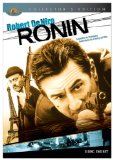(Portions of this review have been pulled from the original one-disc version of Ronin, which can also be found in the reviews portion of the site)Synopsis
I think the only thing I remember about Ronin initially was that Robert DeNiro (Heat) was involved in some scandal involving a French “house of ill-repute” or something along those lines. But when Ronin was released, people quickly forgot about that mess, as what came from it was an action film that put a little more e…fort into the characters than other action films. But that’s not to say the action scenes were neglected; the car chase scenes that negotiate through winding French country roads, and through city sidestreets so narrow you couldn’t open either car door to get out of the car, are some of the most nail biting in recent memory. Based on J.D. Zeik’s story and rewritten by Richard Weisz, a.k.a. David Mamet, Ronin’s introduction is a title card about Japanese samurai without a master, who are mission-less assassins. As a US operative named Sam, DeNiro is introduced almost immediately to the group, who include Frenchman Vincent (Jean Reno, Leon), the Russian, Gregor (Stellan Skarsgard, Dogville) and the Brit, Spence (Sean Bean, Lord of the Rings). Their liaison between them and their employer is the Irish lass Deirdre (Natascha McElhone, Solaris), and their object is a briefcase whose contents are mysterious.
It’s hardly relevant though, as after an initial attempt to ambush the crew, Sam decides his mission is to find out who his employer is, and the reasons for such secrecy. The plot is fairly transparent, and directed by legendary action/suspense director John Frankenheimer (The Manchurian Candidate), the film is really more about the tense driving scenes and the outstanding action scenes. Though for trivia geeks, the movie does boast three James Bond movie villains (Bean was in Goldeneye, Jonathan Pryce from Tomorrow Never Dies and as Vincent’s miniature painting friend Jean-Pierre, Michael Lonsdale from Moonraker). Ronin is good clean fun made more entertaining by Mamet’s contributions to the dialogue, and Frankenheimer’s action scenes are some of the more memorable in recent memory.
Audio
The audio track is the same from the single disc, which is not a problem. While the first half of the movie is based on trying to find out more about this shady cast of characters, the second half, when the car chases and explosions kick in, that’s where the rubber meets the road, no pun intended. The pursuit of the case and the exploding cars winding through the French city and countryside sound fantastic and robust, and when DeNiro uses a rocket launcher to take out a car, it rattles the room.
Video
Dropped is the full frame version of the film, and this “new” edition of Ronin sports the same 2.35:1 anamorphic widescreen as before. The film, which is pretty drab and gray intentionally, transfers OK to disc, with a lot of detail.
Special Features
The good part is that the extras for the first disc were retained and put here, but the bad news is that there wasn’t much of them. There is an alternate ending that shows you what happened to Deirdre at the end of the film, but it apparently didn’t test well, and it was a bit needless. However Frankenheimer does contribute a commentary for the film that is full of information. In it, he points out the cuts and other technical information for the film, and also mentions his influences. We find out that yes, the actors were in the cars for some scenes, and that Formula 1 race car driver were used to drive in others. This may not be on any universal list of good commentary tracks, but I enjoyed it quite a bit. You’ve got the guy who’s directed Black Sunday discussing one of his films, and it’s more conversational, and very engaging.
Moving onto Disc 2 is where the new extras are. “Filming in the Fast Lane” talks about the production, the cast shares their thoughts on the director and the story, and some of the stunts are covered. The interviews are dated, but you take what you can get. The next several featurettes focus on varying aspects of the film, but they all cover the same ground, i.e., what that person wanted to do, some of the more memorable aspects of the production, some biographical information, and what they think of the film now. And that’s fine, but they were all long and somewhat dry for my tastes. “Through the Lens” is a look at the film with cinematographer Robert Fraisse (Seven Years in Tibet), followed by the “Driving of Ronin” with stunt driver Jean Claude Lagniez (Amelie), who does manage to include a funny story about how nervous De Niro was at the onset of the stunt driving. McElhone talks about how the actors worked and what she thought of them, and composer Elia Cmrial (They) talks about the score. Editor Tony Gibbs (Agnes of God) is cued up next to talk about his life and what drew him to editing, as well as working for Frankenheimer, and past some interview footage at the Venice Film Festival with De Niro, Reno and McElhone, there’s a stills gallery set to the film’s score to complete things.
Closing Thoughts
Well, the main differences between the cheap version and this is basically from the extras point of view. The fullscreen version of the film has thankfully been cast aside, the extras are somewhat boring, but at least they are there, which is more than I could say about this the first time around. So if you upgrade, it’s dependent on whether or not you’re an extras junkies. And since I am, you should, if you get my drift.
Special Features List
- Director Commentary
- Alternate Ending
- Making of Featurettes
- Interview Footage
- Still Galleries




